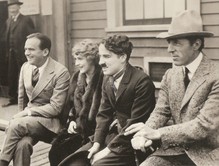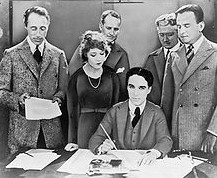
United Artists Corporation
wikipedia | 2013-01-15 14:31
United Artists Corporation (UA) is an American film studio. The original studio of that name was founded in 1919 by D. W. Griffith, Charlie Chaplin, Mary Pickford, and Douglas Fairbanks.
The current United Artists formed in November 2006 under a partnership between producer/actor Tom Cruise and his production partner, Paula Wagner, and Metro-Goldwyn-Mayer Studios Inc., an MGM company. Paula Wagner left the studio on August 14, 2008. Cruise owned a small stake in the studio until late 2011. It is now a fully owned subsidiary of MGM, which itself is owned by MGM Holdings.
History
The early years

Douglas Fairbanks, Mary Pickford, Charlie Chaplin, and D. W. Griffith in 1919
UA was incorporated as a joint venture on February 5, 1919, by four of the leading figures in early Hollywood: Mary Pickford, Charlie Chaplin, Douglas Fairbanks, and D. W. Griffith. Each held a 20% stake, with the remaining 20% held by lawyer William Gibbs McAdoo.The idea for the venture originated with Fairbanks, Chaplin, Pickford, and cowboy star William S. Hart a year earlier as they were traveling around the U.S. selling Liberty bonds to help the World War I effort. Already veterans of Hollywood, the four film stars began to talk of forming their own company to better control their own work as well as their futures.
They were spurred on by established Hollywood producers and distributors who were tightening their control over actor salaries and creative decisions, a process that evolved into the rigid studio system. With the addition of Griffith, planning began, but Hart bowed out before things had formalized. When he heard about their scheme, Richard A. Rowland, head of Metro Pictures, is said to have observed, "The inmates are taking over the asylum." The four partners, with advice from McAdoo (son-in-law and former Treasury Secretary of then-President Woodrow Wilson), formed their distribution company, with Hiram Abrams as its first managing director.
The original terms called for Pickford, Fairbanks, Griffith and Chaplin to independently produce five pictures each year. But by the time the company got under way in 1920–1921, feature films were becoming more expensive and more polished, and running times had settled at around ninety minutes (or eight reels). It was believed that no one, no matter how popular, could produce and star in five quality feature films a year. By 1924, by which time Griffith had dropped out, the company was facing a crisis: either bring in others to help support a costly distribution system or concede defeat. The veteran producer Joseph Schenck was hired as president.
Not only had he been producing pictures for a decade, but he brought along commitments for films starring his wife, Norma Talmadge, his sister-in-law, Constance Talmadge, and his brother-in-law, Buster Keaton. Contracts were signed with a number of independent producers, most notably Samuel Goldwyn, Alexander Korda and Howard Hughes. Schenck also formed a separate partnership with Pickford and Chaplin to buy and build theaters under the United Artists name. They also began international operations, first in Canada, then in Mexico, and by the end of the 1930s, United Artists was represented in over 40 countries.

D.W. Griffith, Mary Pickford, Charlie Chaplin (seated) and Douglas Fairbanks at the signing of the contract establishing United Artists motion picture studio in 1919. Lawyers Albert Banzhaf (left) and Dennis F. O'Brien (right) stand in the background.
Still, even with a broadening of the company, UA struggled. The coming of sound ended the careers of Pickford and Fairbanks.
Chaplin, rich enough to do what he pleased, worked only occasionally. Schenck resigned in 1933 to organize a new company with Darryl F. Zanuck, Twentieth Century Pictures, which soon provided four pictures a year to UA's schedule. He was replaced as president by sales manager Al Lichtman who himself resigned after only a few months. Pickford produced a few films, and at various times Goldwyn, Korda, Walt Disney, Walter Wanger, and David O. Selznick were made "producing partners" (i.e., sharing in the profits), but ownership still rested with the founders. As the years passed and the dynamics of the business changed, these "producing partners" drifted away, Goldwyn and Disney to RKO, Wanger to Universal Pictures, Selznick to retirement. By the late 1940s, United Artists had virtually ceased to exist as either a producer or distributor. It sold off its Mexican releasing division to Crédito Cinematográfico Mexicano, a local company.
Society of Independent Motion Picture Producers (1940s and 1950s)
The Society of Independent Motion Picture Producers was founded in 1941 by Mary Pickford, Charlie Chaplin, Walt Disney, Orson Welles, Samuel Goldwyn, David O. Selznick, Alexander Korda, and Walter Wanger – many of the same people who were members of United Artists. Later members included Hunt Stromberg, William Cagney, Sol Lesser, and Hal Roach.
The Society aimed to advance the interests of independent producers in an industry overwhelmingly controlled by the studio system. SIMPP also fought to end ostensibly anti-competitive practices by the seven major film studios – Loew's, Columbia Pictures, Paramount Pictures, Universal Pictures, RKO Radio Pictures, 20th Century Fox, and Warner Bros./First National – that controlled the production, distribution, and exhibition of films.
In 1942, the SIMPP filed an antitrust suit against Paramount's United Detroit Theatres. The complaint accused Paramount of conspiracy to control first-run and subsequent-run theaters in Detroit. It was the first antitrust suit brought by producers against exhibitors alleging monopoly and restraint of trade.
In 1948, the U.S. Supreme Court Paramount Decision ordered the major Hollywood movie studios – Loew's/MGM, Paramount, Warner Bros./First National, 20th Century Fox and RKO – to sell their theater chains and to eliminate certain anti-competitive practices. This effectively brought an end to the studio system.
By 1958, many of the objectives that led to the creation of the SIMPP had been obtained and SIMPP closed its offices.
Share this page



















